編輯:關於Android編程
尋尋覓覓終於等到你,Material Design系列BottomBar開源庫你值得擁有。從我接觸android開發遇到tabhost,到radioGroup+ViewPage/FrameLayout的演變,再到官方重做tabhost,縱觀歷史演變,淡看風雲變幻,我心依舊,BottomBar你一直都是我的唯一!!
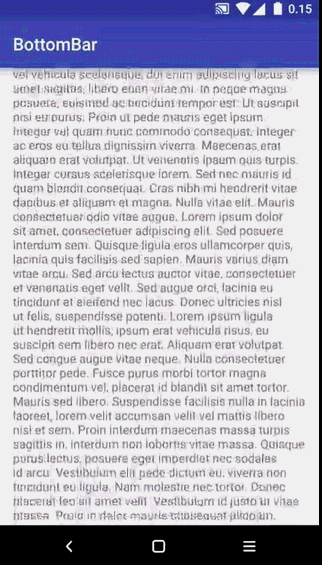
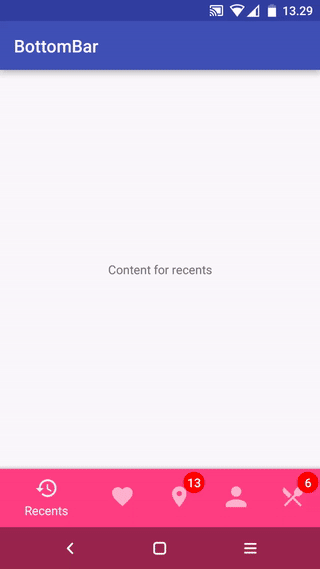
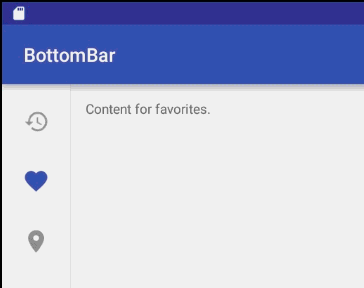
as項目導入(需要注意該庫的sdk限制: minSdkVersion 11)
compile 'com.roughike:bottom-bar:1.3.2'
① 通過添加menu>item資源
* ② Activity內調用我們需要先保存我們的BottomBar狀態,同時也要恢復BottomBar的狀態,具體做法如下:*
//將BottomBar綁定到你的活動,抬高你的布局。
mBottomBar = BottomBar.attach(this, savedInstanceState);
//...................................
@Override
protected void onSaveInstanceState(Bundle outState) {
super.onSaveInstanceState(outState);
// 需要恢復BottomBar的狀態
mBottomBar.onSaveInstanceState(outState);
}
③ 設置不同選項卡對應不同的顏色,Rcolor.colorAccent系統默認主題相關的控件顏色
mBottomBar.mapColorForTab(0, ContextCompat.getColor(this, R.color.colorAccent));
mBottomBar.mapColorForTab(1, 0xFF5D4037);
mBottomBar.mapColorForTab(2, "#7B1FA2");
mBottomBar.mapColorForTab(3, "#FF5252");
mBottomBar.mapColorForTab(4, "#FF9800");
④ 對於MenuItem選中的監聽設置自定義的接口OnMenuTabClickListener
mBottomBar.setItemsFromMenu(R.menu.bottombar_menu, new OnMenuTabClickListener() {
@Override
public void onMenuTabSelected(@IdRes int menuItemId) {
}
@Override
public void onMenuTabReSelected(@IdRes int menuItemId) {
}
});
⑤ 如果BottomBar的功能僅此而已還不值得我為此點贊,導航Tab在Im通信領域的消息count顯示,BottomBar也為我們做了很好地實現
//tab對應消息count以及顏色設定
BottomBarBadge unreadMessages = mBottomBar.makeBadgeForTabAt(0, "#FF0000", 13);
// 控制顯示與否
unreadMessages.show();
// unreadMessages.hide();
// 動態單獨改變現實個數
unreadMessages.setCount(4);
// 改變顯示隱藏的動畫時間
unreadMessages.setAnimationDuration(200);
// 是否沒有選中也要現實消息
unreadMessages.setAutoShowAfterUnSelection(true);
⑥ BottomBar還提供了定制化開發
//禁用左側邊導航
mBottomBar.noTabletGoodness();
// 顯示所有標題即使有超過三個選項卡。
mBottomBar.useFixedMode();
// 使用黑暗的主題。
mBottomBar.useDarkTheme();
// 為活動選項卡設置顏色。忽略了在移動時超過三個選項卡。
mBottomBar.setActiveTabColor("#009688");
// 使用自定義文本出現在選項卡相關配置。
mBottomBar.setTextAppearance(R.style.MyTextAppearance);
// 設置assets目錄下的字體
mBottomBar.setTypeFace("MyFont.ttf");
⑦ BottomBar在界面發生滑動的時候可以把他隱藏,在滑動結束後在顯示出來,不過這樣就需要改變BottomBar保存狀態的方法
mBottomBar = BottomBar.attachShy((CoordinatorLayout) findViewById(R.id.myCoordinator),
findViewById(R.id.myScrollingContent), savedInstanceState);
而xml文件這裡使用CoordinatorLayout為例已對照上列代碼
⑧ BottomBar除了可以通過Menu xml文件導入,我們還可以通過代碼的方式導入項目
mBottomBar.setItems(
new BottomBarTab(R.drawable.ic_recents, "Recents"),
new BottomBarTab(R.drawable.ic_favorites, "Favorites"),
new BottomBarTab(R.drawable.ic_nearby, "Nearby")
);
// Listen for tab changes
mBottomBar.setOnTabClickListener(new OnTabClickListener() {
@Override
public void onTabSelected(int position) {
// The user selected a tab at the specified position
}
@Override
public void onTabReSelected(int position) {
// The user reselected a tab at the specified position!
}
});
⑨ BottomBar雖然不能用xml直接布局,但你仍然可以把它放在任何地方的視圖層次。只要把它綁定到任何你想要的任何視圖位置:
mBottomBar.attach(findViewById(R.id.myContent), savedInstanceState);
⑩ 如果你覺得透明的底部導航讓你覺得不開心,你可以禁用它,但是你必須得注意,該方法必須在填充Item前調用否則會拋出異常(更多使用方法請參照API自行了解)
mBottomBar.noNavBarGoodness();
看完上面的使用簡介,我們再來細嚼慢咽品源碼,我一直相信多學習別人的開源項目我們可以收獲很多,今天一定會斬獲良多。廢話不多說,先看開源項目的結構目錄,我們層層滲入。
BadgeCircle BottomBar BottomBarBadge BottomBarFragment BottomBarItemBase BottomBarTab MisicUtils OnMenuTabClickListener OnSizeDeterminedListener OnTabClickListener OnTabSelectedListener BottomNavigationBehavior VerticalScrollingBehavior
① BadgeCircle輔助類創建一個圓形背景圖,涉及到知識點Drawable系列,shape直接子類OvalShape,而Drawable子類ShapeDrawable構造函數傳入OvaShape實例化創建指定大小顏色的背景圖片。
public class BadgeCircle {
/**
* Creates a new circle for the Badge background.
*
* @param size the width and height for the circle
* @param color the color for the circle
* @return a nice and adorable circle.
*/
protected static ShapeDrawable make(int size, int color) {
ShapeDrawable indicator = new ShapeDrawable(new OvalShape());
indicator.setIntrinsicWidth(size);
indicator.setIntrinsicHeight(size);
indicator.getPaint().setColor(color);
return indicator;
}
}
② 在了解其他類之前我們得先來看看MiscUtils工具類
class MiscUtils {
/**
* 獲取主題顏色
*/
protected static int getColor(Context context, int color) {
TypedValue tv = new TypedValue();
context.getTheme().resolveAttribute(R.attr.colorPrimary, tv, true);
return tv.data;
}
/**
* Converts dps to pixels nicely.
* dp轉px
* @param context the Context for getting the resources
* @param dp dimension in dps
* @return dimension in pixels
*/
protected static int dpToPixel(Context context, float dp) {
Resources resources = context.getResources();
DisplayMetrics metrics = resources.getDisplayMetrics();
return (int) (dp * (metrics.densityDpi / 160f));
}
/**
* Returns screen width.
* 獲取屏幕寬度
* @param context Context to get resources and device specific display metrics
* @return screen width
*/
protected static int getScreenWidth(Context context) {
DisplayMetrics displayMetrics = context.getResources().getDisplayMetrics();
return (int) (displayMetrics.widthPixels / displayMetrics.density);
}
/**
* A hacky method for inflating menus from xml resources to an array
* of BottomBarTabs.
* 從Menu引入BottomBarTab[]資源
* @param activity the activity context for retrieving the MenuInflater.
* @param menuRes the xml menu resource to inflate
* @return an Array of BottomBarTabs.
*/
protected static BottomBarTab[] inflateMenuFromResource(Activity activity, @MenuRes int menuRes) {
// A bit hacky, but hey hey what can I do
PopupMenu popupMenu = new PopupMenu(activity, null);
Menu menu = popupMenu.getMenu();
activity.getMenuInflater().inflate(menuRes, menu);
int menuSize = menu.size();
BottomBarTab[] tabs = new BottomBarTab[menuSize];
for (int i = 0; i < menuSize; i++) {
MenuItem item = menu.getItem(i);
BottomBarTab tab = new BottomBarTab(item.getIcon(),
String.valueOf(item.getTitle()));
tab.id = item.getItemId();
tabs[i] = tab;
}
return tabs;
}
/**
* A method for animating width for the tabs.
* 執行該動畫通過LayoutParams動態改變BottomTabs的寬高
* @param tab tab to animate.
* @param start starting width.
* @param end final width after animation.
*/
protected static void resizeTab(final View tab, float start, float end) {
ValueAnimator animator = ValueAnimator.ofFloat(start, end);
animator.setDuration(150);
animator.addUpdateListener(new ValueAnimator.AnimatorUpdateListener() {
@Override
public void onAnimationUpdate(ValueAnimator animator) {
ViewGroup.LayoutParams params = tab.getLayoutParams();
if (params == null) return;
/***
* 1. Math.ceil()用作向上取整。
* 2. Math.floor()用作向下取整。
* 3. Math.round() 我們數學中常用到的四捨五入取整。
*/
params.width = Math.round((float) animator.getAnimatedValue());
tab.setLayoutParams(params);
}
});
animator.start();
}
/**
* Animate a background color change. Uses Circular Reveal if supported,
* otherwise crossfades the background color in.
* 設備支持(API21)圓形擴散波紋,就用這種方式改變背景,否則就通過淡入淡出背景色的方式
*
* 觸摸點擊view
* @param clickedView the view that was clicked for calculating the start position for the Circular Reveal.
* 當前展示的背景色
* @param backgroundView the currently showing background color.
* 覆蓋後的背景色
* @param bgOverlay the overlay view for the new background color that will be
* animated in.
* 新的顏色
* @param newColor the new color.
*/
@TargetApi(Build.VERSION_CODES.LOLLIPOP)
protected static void animateBGColorChange(View clickedView, final View backgroundView,
final View bgOverlay, final int newColor) {
int centerX = (int) (ViewCompat.getX(clickedView) + (clickedView.getMeasuredWidth() / 2));
int centerY = clickedView.getMeasuredHeight() / 2;
int finalRadius = backgroundView.getWidth();
backgroundView.clearAnimation();
bgOverlay.clearAnimation();
Object animator;
if (Build.VERSION.SDK_INT >= Build.VERSION_CODES.LOLLIPOP) {
if (!bgOverlay.isAttachedToWindow()) {
return;
}
// api 21 後引入圓形縮放動畫效果,效果圖如下圖
animator = ViewAnimationUtils
.createCircularReveal(bgOverlay, centerX, centerY, 0, finalRadius);
} else {
//如果是低版本的僅僅透明度的變化
ViewCompat.setAlpha(bgOverlay, 0);
animator = ViewCompat.animate(bgOverlay).alpha(1);
}
if (animator instanceof ViewPropertyAnimatorCompat) {
((ViewPropertyAnimatorCompat) animator).setListener(new ViewPropertyAnimatorListenerAdapter() {
@Override
public void onAnimationEnd(View view) {
onCancel();
}
//******************此處略*******************
bgOverlay.setBackgroundColor(newColor);
bgOverlay.setVisibility(View.VISIBLE);
}
/**
* A convenience method for setting text appearance.
* 一種設置文本的方便方法,通過傳入文本相關配置對應的資源id
* @param textView a TextView which textAppearance to modify.
* @param resId a style resource for the text appearance.
*/
@SuppressWarnings("deprecation")
protected static void setTextAppearance(TextView textView, int resId) {
if (Build.VERSION.SDK_INT >= Build.VERSION_CODES.M) {
textView.setTextAppearance(resId);
} else {
textView.setTextAppearance(textView.getContext(), resId);
}
}
/**
* Determine if the current UI Mode is Night Mode.
*
* @param context Context to get the configuration.
* @return true if the night mode is enabled, otherwise false.
* 判斷是否是夜間模式
*/
protected static boolean isNightMode(Context context) {
int currentNightMode = context.getResources().getConfiguration().uiMode
& Configuration.UI_MODE_NIGHT_MASK;
return currentNightMode == Configuration.UI_MODE_NIGHT_YES;
}
}
以上Utils有著我們不得不了解的知識點(當然如果你已經知道了可以略過)ViewAnimationUtils.createCircularReveal方法創建圓形擴散波紋,該方法在API21引入,效果如下圖
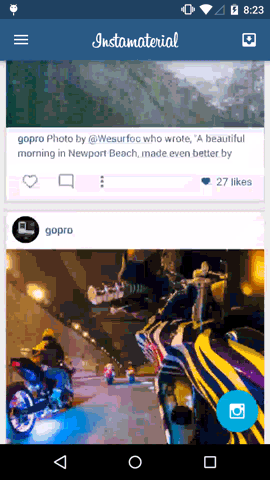
如果要在低版本實現上圖效果,具體采用辦法請參考http://www.cnblogs.com/linguanh/p/4610174.html?utm_source=tuicool&utm_medium=referral
③ Tab導航添加消息count顯示,這裡用到的是自定義TextView控件 BottomBarBadge,內部實現setCount重新調用setText賦值,hide、 show方法實現控件自身的隱藏和顯示(本質是縮放0-1),還提供了一個屬性autoShowAfterUnSelection,對外公開get set,以便於外部判斷調用
/**
* Controls whether you want this Badge to be shown automatically when the
* BottomBar tab containing it is unselected.
* 設置Tab沒有被選中時,是否顯示該控件,默認不顯示
* @param autoShowAfterUnSelection false if you don't want to this Badge reappear every time
* the BottomBar tab containing it is unselected.
*/
public void setAutoShowAfterUnSelection(boolean autoShowAfterUnSelection) {
this.autoShowAfterUnSelection = autoShowAfterUnSelection;
}
我們再來了解一下內部構造方法具體實現
protected BottomBarBadge(Context context, int position, final View tabToAddTo, // Rhyming accidentally! That's a Smoove Move!
int backgroundColor) {
super(context);
ViewGroup.LayoutParams params = new ViewGroup.LayoutParams(
ViewGroup.LayoutParams.WRAP_CONTENT, ViewGroup.LayoutParams.WRAP_CONTENT);
setLayoutParams(params);
setGravity(Gravity.CENTER);
MiscUtils.setTextAppearance(this,
R.style.BB_BottomBarBadge_Text);
int three = MiscUtils.dpToPixel(context, 3);
//設置消息背景
ShapeDrawable backgroundCircle = BadgeCircle.make(three * 3, backgroundColor);
setPadding(three, three, three, three);
//分支適配設置drawable
setBackgroundCompat(backgroundCircle);
FrameLayout container = new FrameLayout(context);
container.setLayoutParams(params);
//先移除child 重新build後重新添加,並添加OnGlobalLayoutListener,從而達到調整位置和大小的目的
ViewGroup parent = (ViewGroup) tabToAddTo.getParent();
parent.removeView(tabToAddTo);
container.setTag(tabToAddTo.getTag());
container.addView(tabToAddTo);
container.addView(this);
parent.addView(container, position);
container.getViewTreeObserver().addOnGlobalLayoutListener(new ViewTreeObserver.OnGlobalLayoutListener() {
@SuppressWarnings("deprecation")
@Override
public void onGlobalLayout() {
adjustPositionAndSize(tabToAddTo);
}
});
④ BottomBarItemBase對象用戶配置BottomBar的基本屬性,比如文字、圖片。內部提供方法沒什麼特別的,不過還是讓我有所發現ContextCompat.getDrawable(Context mContext,int id)方法,以前我都用getDrawabale(id)然而有版本兼容問題,要走分支getDrawable(Context,id),而這部分代碼以前都是自己手寫,當我發現了Compat系列的ContextCompat,一切都變得簡單了,相信很多類似的Compat類都有很多很不錯的方法實現,空余時間可以多看看
/**
* Return a drawable object associated with a particular resource ID.
*
* Starting in {@link android.os.Build.VERSION_CODES#LOLLIPOP}, the returned * drawable will be styled for the specified Context's theme. * * @param id The desired resource identifier, as generated by the aapt tool. * This integer encodes the package, type, and resource entry. * The value 0 is an invalid identifier. * @return Drawable An object that can be used to draw this resource. */ public static final Drawable getDrawable(Context context, int id) { final int version = Build.VERSION.SDK_INT; if (version >= 21) { return ContextCompatApi21.getDrawable(context, id); } else { return context.getResources().getDrawable(id); } }
⑥ BottomBarTab只是對於BottomBarItemBase的繼承,沒做跟多的操作,修改了多種創建方式,這裡不作多介紹了
由淺入深,我們接著來看看這些接口定義到底有什麼作用,當然OnMenuTabSelectedListener、OnTabSelectedListener以及BottomBarFragment這些過時類就不了解了,順便提一句,讓類或者方法過時直接在其上面添加注解@Deprecated即可。(這個開源項目廢棄已有的接口原因在於Tab的重復選擇監聽)
/**
* updateSelectedTab()方法內部通過notifyRegularListener()進行回調
**/
public interface OnTabClickListener {
/**
* The method being called when currently visible {@link BottomBarTab} changes.
* BottomBarTab方式被引入,當前Tab被選中
* This listener is fired for the first time after the items have been set and
* also after a configuration change, such as when screen orientation changes
* from portrait to landscape.
*
* @param position the new visible {@link BottomBarTab}
*/
void onTabSelected(int position);
/**
* The method being called when currently visible {@link BottomBarTab} is
* reselected. Use this method for scrolling to the top of your content,
* as recommended by the Material Design spec
* BottomBarTab方式被引入,當前Tab被重新選中
* @param position the {@link BottomBarTab} that was reselected.
*/
void onTabReSelected(int position);
}
/**
* updateSelectedTab()方法內部通過notifyMenuListener()進行回調
**/
public interface OnMenuTabClickListener {
/**
* The method being called when currently visible {@link BottomBarTab} changes.
*
* This listener is fired for the first time after the items have been set and
* also after a configuration change, such as when screen orientation changes
* from portrait to landscape.
* Menu布局xml方式被引入,第一次選中
* @param menuItemId the new visible tab's id that
* was assigned in the menu xml resource file.
*/
void onMenuTabSelected(@IdRes int menuItemId);
/**
* The method being called when currently visible {@link BottomBarTab} is
* reselected. Use this method for scrolling to the top of your content,
* as recommended by the Material Design spec
* Menu布局xml方式被引入,重新選中
* @param menuItemId the reselected tab's id that was assigned in the menu
* xml resource file.
*/
void onMenuTabReSelected(@IdRes int menuItemId);
}
漫長的篇幅還沒看到核心部位,請君息怒!!BottomBar告訴我,我們必須的在了解Behavior才行,Behavior是位於CoordinatorLayout下面的抽象類,先開始我們的解讀CoordinatorLayout之旅,從該開源項目結構目錄發現,用到了Nested系列的知識,so 我們必須了解下面這幾個類:NestedScrollingParentHelper 、NestedScrollingParent 、NestedScrollingChildHelper、NestedScrollingChild
NestedScrollingParent接口定義解讀:
/**
* 這個接口應該實現由{ @link android.view。ViewGroup ViewGroup }子類希望支持滾動操作委托由一個嵌套的子
* 實現類內部調用了ViewCompat 、ViewGroupCompat的靜態方法(版本分支兼容) ,這樣可以確保與嵌套滾動視圖在5.0 + - 的兼容
**/
public interface NestedScrollingParent {
/**
* 該方法表示滑動開始的調用,直到滑動結束調用onStopNestedScroll方法的調用
* @param child 當前ViewGroup直接的子View
* @param 開始嵌套滾動的視圖View
* @param 需要嵌套滾動的軸:水平、垂直{@link ViewCompat#SCROLL_AXIS_HORIZONTAL},{@link ViewCompat#SCROLL_AXIS_VERTICAL} or both
* @return true 如果這個ViewParent接受嵌套滾動操作返回boolean值true
*/
public boolean onStartNestedScroll(View child, View target, int nestedScrollAxes);
/**
* 如果onStartNestedScroll(View, View, int) onStartNestedScroll} returns true.則會調用該方法,表示接受了嵌套滾動
*/
public void onNestedScrollAccepted(View child, View target, int nestedScrollAxes);
/**
* MotionEvent.ACTION_UP or MotionEvent.ACTION_CANCEL表示滑動結束,回調該函數
*/
public void onStopNestedScroll(View target);
/**
* 嵌套滑動進度,
*
* @param target The descendent view controlling the nested scroll
* @param dxConsumed 已經水平滾動了得距離
* @param dyConsumed 已經垂直滾動了得距離
* @param dxUnconsumed 水平還能滾動的距離
* @param dyUnconsumed 垂直還能滾動的距離
*/
public void onNestedScroll(View target, int dxConsumed, int dyConsumed,
int dxUnconsumed, int dyUnconsumed);
/**
* 每次滑動前,Child 先詢問 Parent 是否需要滑動,即 dispatchNestedPreScroll(),
* 這就回調到 Parent 的 onNestedPreScroll(),在這裡可以攔截child的滑動
*
* @param target View that initiated the nested scroll
* @param dx 水平滾動距離
* @param dy 垂直滾動距離
* @param consumed Output. The horizontal and vertical scroll distance consumed by this parent
*/
public void onNestedPreScroll(View target, int dx, int dy, int[] consumed);
/**
* 當進行fling滑動時回調
*
* @param target View that initiated the nested scroll
* @param velocityX 水平滑動速度
* @param velocityY 垂直滑動速度
* @param consumed true if the child consumed the fling, false otherwise
* @return true if this parent consumed or otherwise reacted to the fling
*/
public boolean onNestedFling(View target, float velocityX, float velocityY, boolean consumed);
/**
* 處理fling動作的,我們在滑動松開手的時候,視圖還繼續滑動一會,這種效果onNestedPreFling就派上用場了
* @param target View that initiated the nested scroll
* @param velocityX 水平滑動速度
* @param velocityY 垂直滑動速度
* @return true if this parent consumed the fling ahead of the target view
*/
public boolean onNestedPreFling(View target, float velocityX, float velocityY);
/**
* 獲取當前滑動的方向
* @see ViewCompat#SCROLL_AXIS_HORIZONTAL
* @see ViewCompat#SCROLL_AXIS_VERTICAL
* @see ViewCompat#SCROLL_AXIS_NONE
*/
public int getNestedScrollAxes();
}
NestedScrollingChild接口定義解讀
/**
* 支持嵌套滾動調度
* 方法處理基本由NestedScrollingChildHelper代理
*/
public interface NestedScrollingChild {
/**
* 啟用或禁用嵌套滾動視圖。
* 如果這個屬性被設置為true視圖將允許嵌套滾動操作與兼容的父視圖在當前的層次結構。
* 如果這視圖沒有實現嵌套滾動這將沒有影響。
*
* @see #isNestedScrollingEnabled()
*/
public void setNestedScrollingEnabled(boolean enabled);
public boolean isNestedScrollingEnabled();
/**
* 開始嵌套滾動,傳入嵌套滾動方向
* 告訴 Parent,你要准備進入滑動狀態了,調用startNestedScroll()。
*/
public boolean startNestedScroll(int axes);
/**
* 停止嵌套滾動
*/
public void stopNestedScroll();
/**
* 該嵌套滾動視圖是否有父布局.
*/
public boolean hasNestedScrollingParent();
/**
* 派遣嵌套滾動視圖的滾動進度
* 如果父類滑動了一定距離,你需要重新計算一下父類滑動後剩下給你的滑動距離余量。
* 然後,你自己進行余下的滑動。最後,如果滑動距離還有剩余,你就再問一下,Parent
* 是否需要在繼續滑動你剩下的距離,也就是調用dispatchNestedScroll()。
*
* @param dxConsumed 水平滾動距離
* @param dyConsumed 垂直滾動距離
* @param dxUnconsumed 水平還能滾動的距離
* @param dyUnconsumed 垂直還能滾動的距離
* @param offsetInWindow 可選項
*/
public boolean dispatchNestedScroll(int dxConsumed, int dyConsumed,
int dxUnconsumed, int dyUnconsumed, int[] offsetInWindow);
/**
* 在滑動之前,先問一下你的 Parent 是否需要滑動,也就是調用dispatchNestedPreScroll()。
*
* @param dx
* @param dy
* @param consumed
* @param offsetInWindow View的窗體偏移量
*/
public boolean dispatchNestedPreScroll(int dx, int dy, int[] consumed, int[] offsetInWindow);
/***************略***************
}
NestedScrollingParentHelper類內部方法的實現主要在改變變量:mViewGroup、mNestedScrollAxes,不做過多解釋,NestedScrollingChildHelper對NestedScrollingChild接口的代理實現,方法的實現主要以Compat系列的靜態方法調用為主,ViewCompatImpl、ViewParentCompatImpl根據SDK對應不同的實現
自定義抽象類VerticalScrollingBehavior內部主要注解了滑動方向重寫父類方法,修改滑動方向
public abstract class VerticalScrollingBehavior extends CoordinatorLayout.Behavior {
@Retention(RetentionPolicy.SOURCE)
@IntDef({ScrollDirection.SCROLL_DIRECTION_UP, ScrollDirection.SCROLL_DIRECTION_DOWN})
public @interface ScrollDirection {
int SCROLL_DIRECTION_UP = 1;
int SCROLL_DIRECTION_DOWN = -1;
int SCROLL_NONE = 0;
}
@Override
public void onNestedScroll(CoordinatorLayout coordinatorLayout, V child, View target, int dxConsumed, int dyConsumed, int dxUnconsumed, int dyUnconsumed) {
super.onNestedScroll(coordinatorLayout, child, target, dxConsumed, dyConsumed, dxUnconsumed, dyUnconsumed);
if (dyUnconsumed > 0 && mTotalDyUnconsumed < 0) {
mTotalDyUnconsumed = 0;
mOverScrollDirection = ScrollDirection.SCROLL_DIRECTION_UP;
} else if (dyUnconsumed < 0 && mTotalDyUnconsumed > 0) {
mTotalDyUnconsumed = 0;
mOverScrollDirection = ScrollDirection.SCROLL_DIRECTION_DOWN;
}
mTotalDyUnconsumed += dyUnconsumed;
onNestedVerticalOverScroll(coordinatorLayout, child, mOverScrollDirection, dyConsumed, mTotalDyUnconsumed);
}
@Override
public void onNestedPreScroll(CoordinatorLayout coordinatorLayout, V child, View target, int dx, int dy, int[] consumed) {
super.onNestedPreScroll(coordinatorLayout, child, target, dx, dy, consumed);
if (dy > 0 && mTotalDy < 0) {
mTotalDy = 0;
mScrollDirection = ScrollDirection.SCROLL_DIRECTION_UP;
} else if (dy < 0 && mTotalDy > 0) {
mTotalDy = 0;
mScrollDirection = ScrollDirection.SCROLL_DIRECTION_DOWN;
}
mTotalDy += dy;
onDirectionNestedPreScroll(coordinatorLayout, child, target, dx, dy, consumed, mScrollDirection);
}
@Override
public boolean onNestedFling(CoordinatorLayout coordinatorLayout, V child, View target, float velocityX, float velocityY, boolean consumed) {
super.onNestedFling(coordinatorLayout, child, target, velocityX, velocityY, consumed);
mScrollDirection = velocityY > 0 ? ScrollDirection.SCROLL_DIRECTION_UP : ScrollDirection.SCROLL_DIRECTION_DOWN;
return onNestedDirectionFling(coordinatorLayout, child, target, velocityX, velocityY, mScrollDirection);
}
}
VerticalScrollingBehavior 的具體實現類BottomNavigationBehavior,根據滑動是調用handleDirection方法判斷是否可以滑動以及滑動方向,最後調用animateOffset動畫實現位移translationY
public class BottomNavigationBehavior extends VerticalScrollingBehavior {
@Override
public void onDirectionNestedPreScroll(CoordinatorLayout coordinatorLayout, V child, View target, int dx, int dy, int[] consumed, @ScrollDirection int scrollDirection) {
handleDirection(child, scrollDirection);
}
private void handleDirection(V child, int scrollDirection) {
if (!mScrollingEnabled) return;
if (scrollDirection == ScrollDirection.SCROLL_DIRECTION_DOWN && hidden) {
hidden = false;
animateOffset(child, mDefaultOffset);
} else if (scrollDirection == ScrollDirection.SCROLL_DIRECTION_UP && !hidden) {
hidden = true;
animateOffset(child, mBottomNavHeight + mDefaultOffset);
}
}
@Override
protected boolean onNestedDirectionFling(CoordinatorLayout coordinatorLayout, V child, View target, float velocityX, float velocityY, @ScrollDirection int scrollDirection) {
handleDirection(child, scrollDirection);
return true;
}
private void animateOffset(final V child, final int offset) {
ensureOrCancelAnimator(child);
mTranslationAnimator.translationY(offset).start();
}
private void ensureOrCancelAnimator(V child) {
if (mTranslationAnimator == null) {
mTranslationAnimator = ViewCompat.animate(child);
mTranslationAnimator.setDuration(300);
mTranslationAnimator.setInterpolator(INTERPOLATOR);
} else {
mTranslationAnimator.cancel();
}
}
}
BottomBar內部源碼篇幅太長,提煉出一下幾點核心方法,具體代碼實現自己查看源碼吧一眼看穿就不做過多解釋了
① clearItems();
② updateItems(mItems);
③ unselectTab(oldTab, animate);
④ selectTab(newTab, animate);
⑤ updateSelectedTab(position);
⑥ shiftingMagic(oldTab, newTab, false);
⑦ setDefaultTabPosition()
⑧ setBarVisibility()
⑨ useDarkTheme()
⑩ notifyMenuListener()
? notifyRegularListener()
 Android 自定義View視圖
Android 自定義View視圖
創建全新的視圖將滿足我們獨特的UI需求。 本文介紹在指南針開發中會用到的羅盤的界面UI,通過繼承View類實現的自定義視圖,以此來深刻了解自定義視圖。 實現效果圖:
 Android開發之天氣趨勢折線圖
Android開發之天氣趨勢折線圖
先來看下效果:控件內容比較簡單,就是一個普通的折線圖,上下分別帶有數字,點擊的時候顯示當天溫度的差值。 創建一個類繼承自View,並添加兩個構造方法:publi
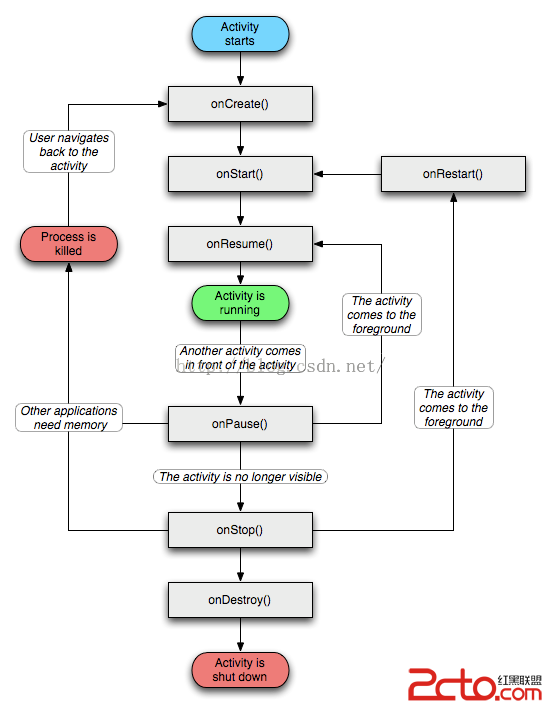 [better practice系列]Android處理好activity正確情況下的生命周期和意外情況下的生命周期淺析
[better practice系列]Android處理好activity正確情況下的生命周期和意外情況下的生命周期淺析
前言:Activity生命周期是每一個Android開發者接觸Android之始就會學習的東西,每個人都會說出點什麼,我想任何一個經驗老道高級語言開發程序員談到生命周期這
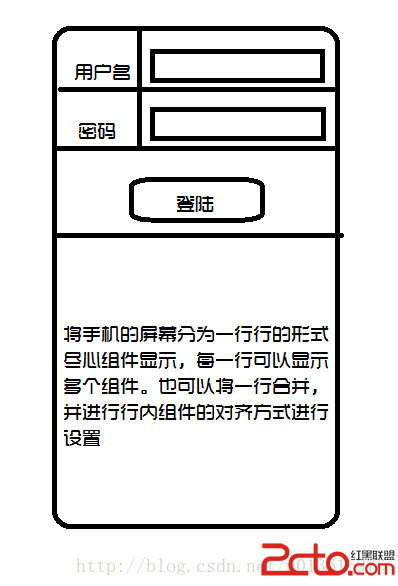 從零開始學android(Tablelayout表格布局.十五.)
從零開始學android(Tablelayout表格布局.十五.)
TableLayout就是將手機的屏幕分為一行行的形式進行數據的顯示,並且一行可以多個控件 並且可以設置控件的對齊方式,和是否為可收縮行 下面通過一行圖和一個簡單的例子來